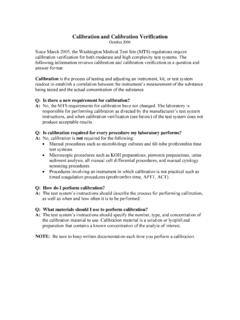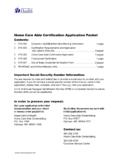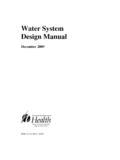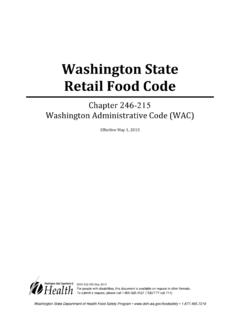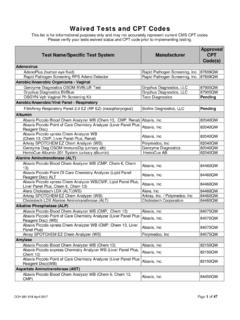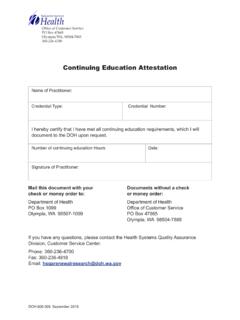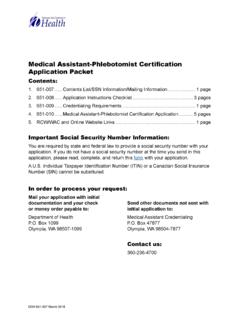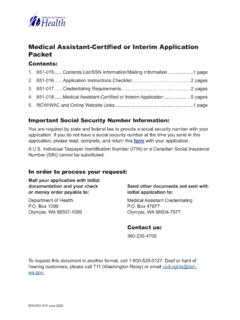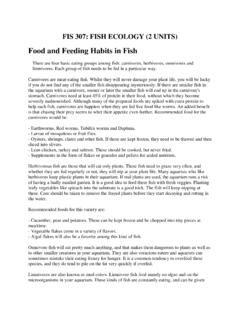Transcription of Food Safety is Everybody’s Business
1 food Safety is everybody 's Business Your guide to preventing foodborne illness Washington State food & Beverage Workers' Manual Table of Contents Part 1: Welcome to food Safety 1. Most foodborne illnesses are caused by germs 2. Certain people get sick more often 3. Hazards in food 4. Biological hazards (germs) in food 6. Part 2: Three practices prevent almost all foodborne illnesses 8. food Safety practice: Personal hygiene 9. Handwashing 10. Avoiding bare hand contact with ready-to-eat foods 12. Personal habits 13. food Safety practice: Temperature Control 14. Thermometers 15. Cooking and keeping hot foods hot 16. Cooling and keeping cold foods cold 18. food Safety practice: Prevention of Cross Contamination 20.
2 Washing, rinsing, and sanitizing 21. Additional food Safety issues 22. Special reminders for food workers 24. The information provided in this manual is based on the Washington State Retail food Code WAC 246-215 and is intended to be used in conjunction with approved food Worker Training. This handbook does not represent all requirements provided in the Washington State Retail food Code. For more information, contact your local health department. DOH 332-036 May 2013. For people with disabilities, this document is available on request in other formats. To submit a request, please call 1-800-525-0127 (TDD/TTY call 711). Thank you. We appreciate that you are taking an active role in learning to prepare and serve safe food .
3 As a food worker, you will be making food for other people. They trust you to do all that you can to keep their food safe. It is your responsibility to safely prepare and serve food to them so they will not get sick. The information in this manual will give you tips to safely store, prepare, and serve food at work and home. The manual is divided into two parts: Part 1 Introduction to foodborne illness Part 2 How to keep food from causing illness By the time you have finished this manual you will: 1. Understand there are many causes of foodborne illness. 2. Identify the importance of clean hands and healthy food workers. 3. Know how avoiding the Danger Zone helps prevent foodborne illness.
4 4. Learn several tips to help you remember food Safety basics. 5. Recognize your responsibilities as a food worker. food Safety knowledge can help you protect yourself and others. Please take what you learn from this manual and use it at your workplace and in your home. If you have any questions, please call your local health department. Remember that food workers using proper food Safety practices are the most important ingredient in safe food . Welcome to the food Safety team in Washington State. Page 1 food Safety Tip: food Safety is important at home and required at work. Foodborne Illness Foodborne illnesses People can get sick if the food they eat has harmful chemicals or germs.
5 This do not just happen at is called foodborne illness. Most foodborne illnesses are either food restaurants. poisonings or foodborne infections. Everyone that When people talk about foodborne illness, they often call it food poisoning. handles food can Chemicals, bacteria, or certain foods like poisonous mushrooms can cause spread foodborne food poisoning. Symptoms of food poisoning are usually noticed within hours illness. after eating, and often include vomiting. Germs that cause The most common foodborne illnesses, however, are not caused by food foodborne illness are poisoning. They are foodborne infections caused by germs that grow in food or inside of our bodies. Symptoms of foodborne infections include usually bacteria, diarrhea, vomiting, fever, headache, and stomach aches.
6 Symptoms may viruses, or parasites. be noticed from several hours to several weeks after eating the food . In the United States, the Centers for Disease Control estimates that about 48 million Americans get sick and up to 3,000 people die each year from unsafe food . Following the food Safety practices in this manual can help you prevent the most common causes of foodborne illness. Person in Charge: Someone at each establishment must be in charge during all hours of operation and must make sure that all food Safety steps are followed. The person in charge must know the Washington State Retail food Code and the procedures used in the establishment. If you have questions, ask the person in charge.
7 If you are the person in charge, you should be able to give food workers training or information needed to perform their jobs correctly. Page 2 food Safety Tip: Almost all foodborne illnesses can be prevented. Highly Susceptible Populations Certain foods are Although anyone can get sick from food handled unsafely, certain people more likely to cause usually get sick more often or have more serious illnesses. These people are foodborne illness in called the Highly Susceptible Population. They are: highly susceptible Younger than 5 years old. people. Older than 65 years old. These foods include: Pregnant. undercooked meats Immune-compromised (due to cancer, AIDS, diabetes, certain raw oysters medications, or other conditions).
8 Undercooked eggs sprouts In order to remember the people in the group, the group is sometimes called by the name YOPI (yo p ). unpasteurized milk or juices Facilities like hospitals, child care centers, preschools, nursing homes, and adult care homes that provide food and services to a Highly Susceptible Population have additional food Safety requirements. Several of these requirements are highlighted throughout this manual. For more information, call your local health department. Page 3 food Safety Tip: Certain people are more likely to get sick from unsafe food . Hazards in food The goal of food Safety is to prevent the hazards that cause foodborne illness or injury. Most of the hazards in food are things you cannot see, smell, or taste.
9 A foodborne hazard is a physical, chemical, or biological object in food or drink that can cause injury or illness. Most foodborne illnesses are caused by biological hazards (germs). Hazard Examples It happened in Washington . Hard or soft objects in food that Several staples were found in a can cause injury. Examples birthday cake from a bakery in Physical include broken glass, jewelry, Eastern Washington. The cake was adhesive bandages, staples, prepared below papers stapled to a and fingernails. memo board. Poisonous substances that Due to a broken valve in a soda occur naturally or are added machine, several Western Chemical during food handling. Examples Washington customers got copper include cleaning agents, poisoning within minutes after pesticides, and certain metals.
10 Drinking soft drinks. Germs that cannot be seen Several customers became infected without a microscope. with hepatitis A after eating Biological Examples include parasites, sandwiches prepared by an ill food bacteria, and viruses. worker in Western Washington. Physical Hazards Physical hazards are objects in food that may cause injury if eaten. Physical hazards usually happen because of unsafe food handling practices or accidental contamination. To prevent physical contamination: Wash fruits and vegetables carefully. Look closely at the foods you prepare. Keep the food preparation area free of things that can fall into the food . Page 4 food Safety Tip: Most foodborne illnesses are caused by germs.
